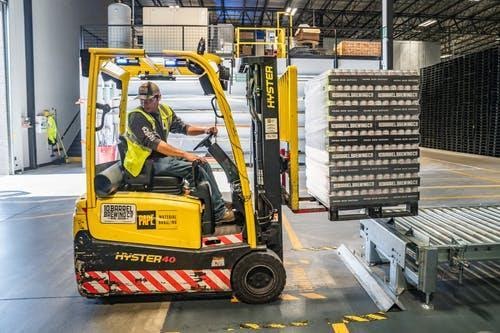Material Handling is a process of controlling, moving, and protecting industrial materials starting from their initial manufacturing process to the final production. The materials are needed to be handled carefully during the entire process. The process also includes storing the materials in a secured place and transporting them for distribution. Therefore, material handling is necessary to safeguard the materials and continue the workflow smoothly and effectively.
Automation technologies are also introduced for instant material handling, which speeds up the process. It is less time-consuming and does the complete work with perfection. Material handling is considered essential in the supply chain process because of the involvement of packaging, shipping, delivering, and transportation of goods. For more information about the material handling process, here is the?guide to material handling, where you will get the important basic ideas regarding the process.

Types Of Material Handling
There are two major material handling types?manual and automated material handling. Let’s discuss these two types briefly in the guide to material handling.
Manual handling?
In the manual process of handling materials, workers are involved. Workers do the complete process and deal with the types of machinery from the manufacturing process to production. While transporting, the workers move the containers; this involves lifting, filling, emptying, and carrying them.
The manual process has been dreadful for the workers because of the higher risk of accidents during shifting the materials and working with huge machinery. Workers also suffer from pains and sprains during the process. This process also lowers productivity as it is time-consuming and needs more human effort.
There is even equipment used in the manual process to increase the workflow. Manual carts are referred to that can be operated by humans and manually moved from one place to another. The carts consist of wheels and handlebars to easily operate by the workers. Material handling equipment comprises forklifts, reach trucks, pallet trucks and other material handling accessories.
Automated Handling
Technological development in automation has been seen in various developed industries. The use of automation in material handling has become more productive. The automated process has changed the work process and made it more effective. It has reduced the involvement of human efforts and become a time-saving method that leads to more economic productivity.
The process helped in loading, unloading, shifting, and transporting materials less. The rise in technological development and improvements have upgraded automated techniques like robotics, machine learning, programming, and other automated services in the industrial units.
Basic Fundamentals Involved In Material Handling
In the guide to material handling, let’s focus on the fundamentals and principles of material handling.
Orientation is the most important principle, and it helps in promoting the assessment of an available system that is before the preliminary plan. This fundamental also includes the evaluation of various problems and methods that exist.
Planning is another basic fundamental which includes basic requirements of handling materials and other necessary things to operate the process.
The process of storing and handling integrated activities is involved within the system, and it is cost-efficient. The products are handled through unit loads in the system.
The utilization of space is a basic fundamental process in which the available space is utilized efficiently in a smart manner.
The standardization principle helps to encourage the material handling methods for better performance and results. Through ergonomics, the limitations and capabilities of human involvement are recognized.
The fundamental also includes the total energy consumption during the entire material handling process. And the process must show minimum impact on the ecology.
Mechanization encourages efficiency in the process, and flexibility states the practical nature of the equipment. The simplification principle controls workflow smoothly without making it complex.
Effect Of Material Handling Process in the Supply Chain Management
The material handling process plays a vital role in supply chain management. The process relates to the supply chain’s manufacturing, transporting, and distribution.
The materials are manufactured and turned into finished products in the manufacturing process. The transportation process includes sending the products to the destination, such as the warehouse, wholesalers, and others. After the products reach their destination, it is needed to unload them to a safe place. The products are shifted to the warehouses and placed on the racks. The products get delivered to the customers through retail stores in the final distribution process.
Beneficial Properties Of Material Handling
There are various benefits and advantages of material handling. It has been effective for many years in the industrial sectors. The industries are widely preferring the automated material handling process. The guide to material handling will let you understand the core benefits of this process.
This process’s advanced improvement and development have become more efficient and productive for industrial growth. The process eventually saves money; therefore, it is considered cost-effective. It increases the safety of workers as it doesn’t involve more human efforts or muscle power.
The process reduces the downtime and speeds up the production process to reach the customers in time. It improves the ergonomics factor, which further increases efficiency. Due to the advanced material handling, the traffic of transportation has reduced. It has improved flexibility in the working environment.

As the editor of the blog, She curate insightful content that sparks curiosity and fosters learning. With a passion for storytelling and a keen eye for detail, she strive to bring diverse perspectives and engaging narratives to readers, ensuring every piece informs, inspires, and enriches.








